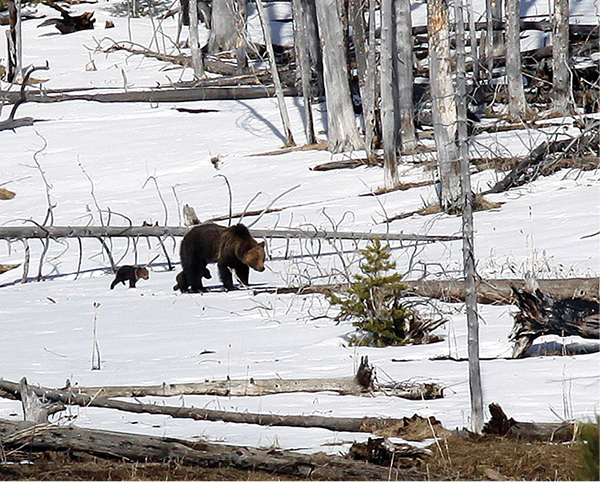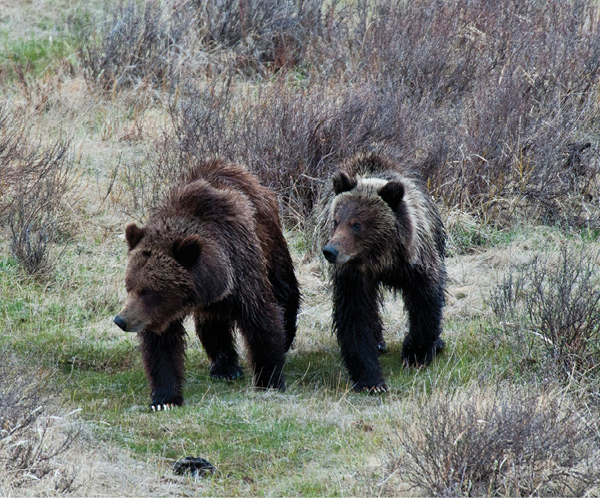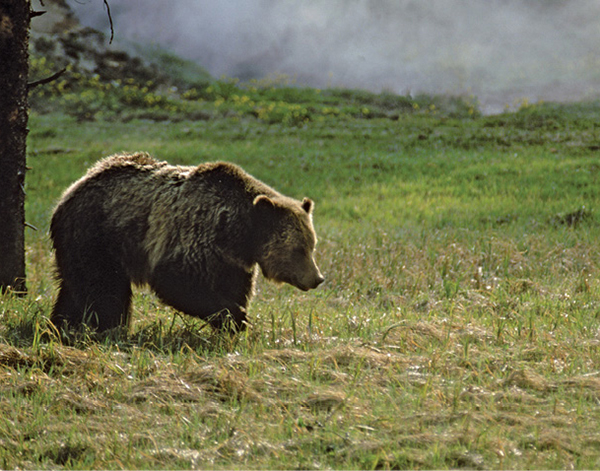
Grizzly bear females with new cubs are the last to emerge from their dens and may temporarily return to their dens for shelter. Photo Kevin Rhoades
Nurturing Cubs to Adulthood
In general, sows with cubs are the last grizzly bears to awaken from hibernation in the spring. While the mother bear is still lethargic from her long winter’s sleep, the cubs are playful and energetic. Females with young often stay close to the den site for several weeks and may sometimes temporarily return to the den for shelter.
For the first several months of life, grizzly bear cubs are highly dependent on their mother’s milk for nourishment. Like adult bears, grizzly cubs are very intelligent. From an early age they are constantly observing their mother’s behavior and mimic it with actions of their own. This pattern enables them to master skills they’ll need in adulthood, such as feeding strategies. Cubs eat the foods their mother provides for them and quickly learn to find and harvest them on their own. Grizzly cubs also prepare for adult life with their seemingly boundless enthusiasm for play. Siblings from the same litter spend many hours wrestling on the ground or grappling while they stand upright on their hind legs. They like to chase one another or play what appears to be a game of follow-the-leader that may find them climbing on logs or scrambling over boulders.
More elaborate amusements are sometimes observed among individual cubs. In Yellowstone National Park I once observed a sow and her two yearling cubs scavenging an old bison carcass. The carcass had decomposed to just a skeleton, but the mother and one of the cubs seemed quite content to gnaw on the bones. The other cub had a different agenda. Grasping a sizeable bone in its forepaws, it rolled onto its back and proceeded to toss the bone in the air. Thinking it a random but fascinating act, I grinned with delight at having the opportunity to observe and photograph such a unique, playful behavior. My delight turned to astonishment when the cub spent the next couple minutes deliberately tossing the bone aloft with its front paws and attempting to catch it. Such activities probably develop dexterity among young bears and also enhance their problem-solving skills. What’s next? I thought as the bears finally ambled away. Is this youngster going to figure out how to juggle with bison bones?

Grizzly bear females with new cubs are the last to emerge from their dens and may temporarily return to their dens for shelter. Photo Kevin Rhoades
Young grizzly bears typically stay with their mother until they are 2 years old. As they age, they become increasingly less dependent upon the sow for care, although 2-year-old offspring have been observed nursing. Separation of mothers and their young may be triggered by her readiness to mate and produce another litter. Adult male grizzly bears are a persistent threat to cubs. For their first year of life, a grizzly sow will attempt to protect her cubs from an aggressive male. Grizzly bears can efficiently climb trees in their first year of life, a strategy they may use to elude the jaws of a threatening male. Scientists believe male bears may kill cubs for a variety of reasons. In some cases the cubs are eaten. Removing cubs from a female bear may also make her more apt to breed. It has also been theorized that boars kill cubs that have been sired by other males, increasing the likelihood that young in a particular area are the offspring of the dominant male. Whatever the motivation, adult males of their own kind are one of the hazards cubs must avoid in order to reach adulthood.
The fact that grizzly sows normally invest what amounts to 3 years from the time they breed until their cubs depart and they breed again is one of the reasons grizzlies have one of the lowest reproductive rates of any North American mammal. Another factor involves their slow pace toward sexual maturity. Grizzly bear females normally become capable of reproduction at between 4 and 7 years of age. Males usually reach sexual maturity at 4 to 6 years of age.
The age at which a female births her first litter and becomes part of the reproducing population of grizzly bears varies substantially by region. Nutrition plays a big factor in when a grizzly sow is able to produce her first litter. Bears on the Alaskan Peninsula, where food is abundant, often birth their first litter at 4 or 5 years of age. In Yellowstone National Park the average age of first reproduction for females averages around 6 years of age. Areas that offer bears poorer access to nutritious forage may see few females reproducing until they are 7 or 8 years old. Once they reach breeding age, sow grizzlies may produce young until they are 20 years old or more. Given the grizzly bear’s slow rate of sexual maturity and reproduction, the loss of even a few breeding-age females in a small population may greatly reduce its viability.

Grizzly sows often nurture their cubs for 2 years after birth. These yearlings are nursing.

Grizzly bears have one of the lowest reproductive rates of any North American mammal. Photo William Mullins

Although she may only birth cubs every 3 years or more, a grizzly sow like this one in Yellowstone National Park can successfully raise cubs to age 20.